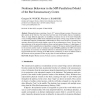Free Online Productivity Tools
i2Speak
i2Symbol
i2OCR
iTex2Img
iWeb2Print
iWeb2Shot
i2Type
iPdf2Split
iPdf2Merge
i2Bopomofo
i2Arabic
i2Style
i2Image
i2PDF
iLatex2Rtf
Sci2ools
INFORMATICALT
2008
2008
Nonlinear Behaviour in the MPI-Parallelised Model of the Rat Somatosensory Cortex
Mammalian brains consisting of up to 1011 neurons belong to group of the most complex systems in the Universe. For years they have been one of the hardest objects of simulation. There are many different approaches to modelling of neurons, but one of the most biologically correct is Hodgkin-Huxley (HH) model. Simulations that require solving a large number of nonlinear differential equations (fundamental in HH model) are always time and power consuming. The structures discussed in this article simulate a part of the rat somatosensory cortex. We use a modular architecture of the network divided into layers and sub-regions. Because of a high degree of complexity effective parallelisation of algorithms is required. We propose method of parallelisation for the network and the results of simulations using GENESIS parallelised for MPI environment are presented. An occurrence of nonlinear behaviour is demonstrated. Most notably, in large biological neural networks consisting of the HH neurons,...
| Added | 12 Dec 2010 |
| Updated | 12 Dec 2010 |
| Type | Journal |
| Year | 2008 |
| Where | INFORMATICALT |
| Authors | Grzegorz M. Wojcik, Wieslaw A. Kaminski |
Comments (0)

